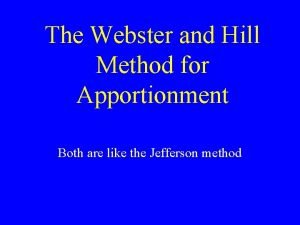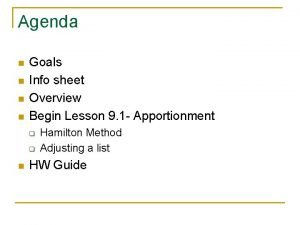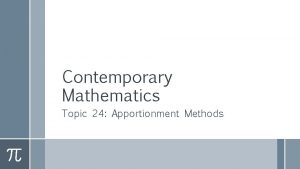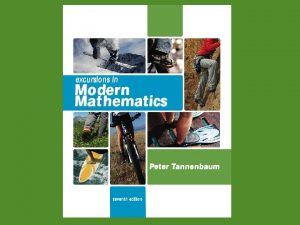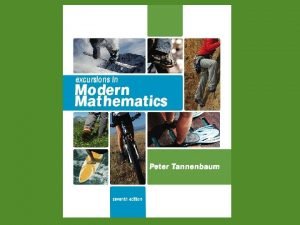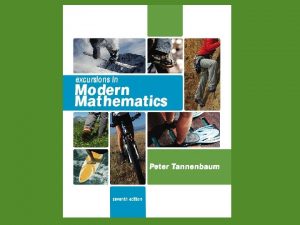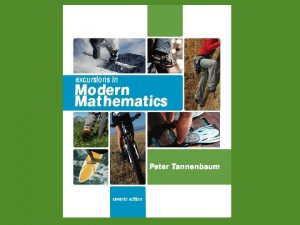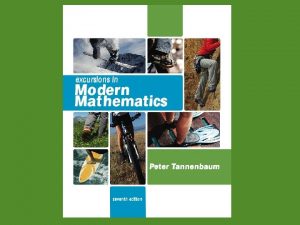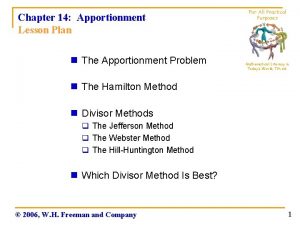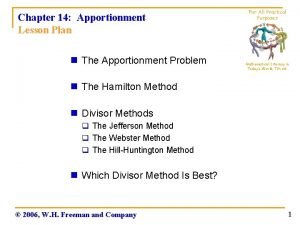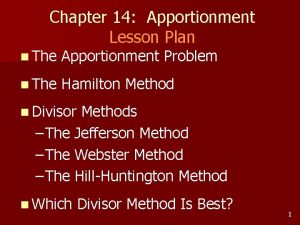4 The Mathematics of Apportionment 4 1 Apportionment











- Slides: 11


4 The Mathematics of Apportionment 4. 1 Apportionment Problems 4. 2 Hamilton’s Method and the Quota Rule 4. 3 The Alabama and Other Paradoxes 4. 4 Jefferson’s Method 4. 5 Adam’s Method 4. 6 Webster’s Method Copyright © 2010 Pearson Education, Inc. Excursions in Modern Mathematics, 7 e: 4. 6 - 2

Webster’s Method What is the obvious compromise between rounding all the quotas down (Jefferson’s method) and rounding all the quotas up (Adams’ method)? What about conventional rounding (Round the quotas down when the fractional part is less than 0. 5 and up otherwise. )? Now that we know that we can use modified divisors to manipulate the quotas, it is always possible to find a suitable divisor that will make conventional rounding work. This is the idea behind Webster’s method. Copyright © 2010 Pearson Education, Inc. Excursions in Modern Mathematics, 7 e: 4. 6 - 3

WEBSTER’S METHOD Step 1 Find a “suitable” divisor D. Step 2 Using D as the divisor, compute each state’s modified quota (modified quota = state population/D). Step 3 Find the apportionment by rounding each modified quota the conventional way. Copyright © 2010 Pearson Education, Inc. Excursions in Modern Mathematics, 7 e: 4. 6 - 4

Example 4. 10 Parador’s Congress (Webster’s Method) Our first decision is to make a guess at the divisor D: Should it be more than the standard divisor (50, 000), or should it be less? Use the standard quotas as a starting point. When we round off the standard quotas to the nearest integer, we get a total of 251 (row 4 of Table 416). This number is too high (just by one seat), which tells us that we should try a divisor D a tad larger than the standard divisor. We try D = 50, 100. Copyright © 2010 Pearson Education, Inc. Excursions in Modern Mathematics, 7 e: 4. 6 - 5

Example 4. 9 Parador’s Congress (Webster’s Method) Row 5 shows the respective modified quotas, and the last row shows these quotas rounded to the nearest integer. Now we have a valid apportionment! The last row shows the final apportionment under Webster’s method. Copyright © 2010 Pearson Education, Inc. Excursions in Modern Mathematics, 7 e: 4. 6 - 6

Webster’s Method A flowchart illustrating how to find a suitable divisor D for Webster’s method using educated trial and error is on the next slide. The most significant difference when we use trial and error to implement Webster’s method as opposed to Jefferson’s method is the choice of the starting value of D. With Webster’s method we always start with the standard divisor SD. If we are lucky and SD happens to work, we are done! Copyright © 2010 Pearson Education, Inc. Excursions in Modern Mathematics, 7 e: 4. 6 - 7

Webster’s Method Copyright © 2010 Pearson Education, Inc. Excursions in Modern Mathematics, 7 e: 4. 6 - 8

Webster’s Method When the standard divisor works as a suitable divisor for Webster’s method, every state gets an apportionment that is within 0. 5 of its standard quota. This is as good an apportionment as one can hope for. If the standard divisor doesn’t quite do the job, there will be at least one state with an apportionment that differs by more than 0. 5 from its standard quota. Copyright © 2010 Pearson Education, Inc. Excursions in Modern Mathematics, 7 e: 4. 6 - 9

Webster’s Method In general, Webster’s method tends to produce apportionments that don’t stray too far from the standard quotas, although occasional violations of the quota rule (both lower- and upper-quota violations), but such violations are rare in real-life apportionments. are possible. Webster’s method has a lot going for it–it does not suffer from any paradoxes, and it shows no bias between small and large states. Copyright © 2010 Pearson Education, Inc. Excursions in Modern Mathematics, 7 e: 4. 6 - 10

Webster’s Method Surprisingly, Webster’s method had a rather short tenure in the U. S. House of Representatives. It was used for the apportionment of 1842, then replaced by Hamilton’s method, then reintroduced for the apportionments of 1901, 1911, and 1931, and then replaced again by the Huntington-Hill method, the apportionment method we currently use. Copyright © 2010 Pearson Education, Inc. Excursions in Modern Mathematics, 7 e: 4. 6 - 11
 Objectives of overhead apportionment and absorption
Objectives of overhead apportionment and absorption Webster apportionment method
Webster apportionment method Absolute unfairness of apportionment calculator
Absolute unfairness of apportionment calculator Các châu lục và đại dương trên thế giới
Các châu lục và đại dương trên thế giới Một số thể thơ truyền thống
Một số thể thơ truyền thống Bổ thể
Bổ thể Hệ hô hấp
Hệ hô hấp Số nguyên tố là gì
Số nguyên tố là gì đặc điểm cơ thể của người tối cổ
đặc điểm cơ thể của người tối cổ Chúa yêu trần thế
Chúa yêu trần thế Các châu lục và đại dương trên thế giới
Các châu lục và đại dương trên thế giới ưu thế lai là gì
ưu thế lai là gì

